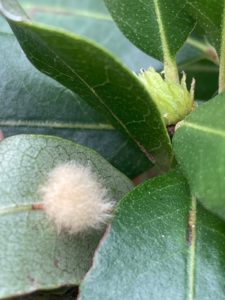
By Mary Reid Barrow
Feathery, leafy, dainty bunches of greenery are growing on the Feeder Road live oaks these days and they look like leaves that got mixed up about which tree they were meant to grow on.
I had never seen these growths that look almost like sea anemones on the twigs before. But once I saw the first ones, I began to notice them again and again on my Feeder Road walks
The more curious I got, the more odd growths I saw on the trees. I saw familiar fuzzy oak galls on the undersides of some leaves and brown round apple oak galls on some of the branches.

Then I realized It’s gall time and our live oaks sure must have a lot of gall this year.
But the leafy one was new to me. It actually is called a leafy oak gall, said Laurie Fox, a horticulture associate at the Hampton Roads Agriculture Research and Extension Center. The Cynipid wasp that created the abnormal growth isAndricus quercusfoliatus and it is one of several species of gall wasps that use live oak trees as a nursery.
Tiny gall wasps, so small you might think they were gnats, lay their eggs in the tissue of a leaf or a twig and then inject a hormone into the tissue, explained Pete Schultz, an entomologist and retired director of the center.
The hormone causes the leaf or twig to grow in an abnormal way that creates protection and food for the larva that hatches from the egg. Though the life cycle varies between species, basically the larva grows up, dining on the interior of its gall, pupates and emerges from the safety of its home as a wasp.
Gall exteriors have a bad taste which protects the little larva inside from predators. Depending on the species of Cynipid wasp, the growth could be fuzzy , leafy or hard and shaped in myriad ways.
Oaks of all species get lots of galls, thanks to about 800 species of gall wasps that cause these many odd growths. But the galls are more evident on live oaks because their branches grow near the ground and you can see them close up.
If I were more observant and had more species of oak leaves and twigs in close view, I might find galls shaped like mushrooms, sea urchins, Hershey’s Kisses, pumpkins, vases, hedgehogs and more, noted Doug Tallamy in “The Nature of Oaks”, a handy book to have, galls or not, if you like oak trees.
In any case, don’t let galls on your trees gall you! For the most part, galls are not harmful to a tree. They just happen to be the wasp’s way of reproducing.
Do you have a favorite tree or plant with a story to tell? What relationships have you observed between plants and critters? Who eats whom? Who has babies where? Send an email to maryreid@lrnow.org